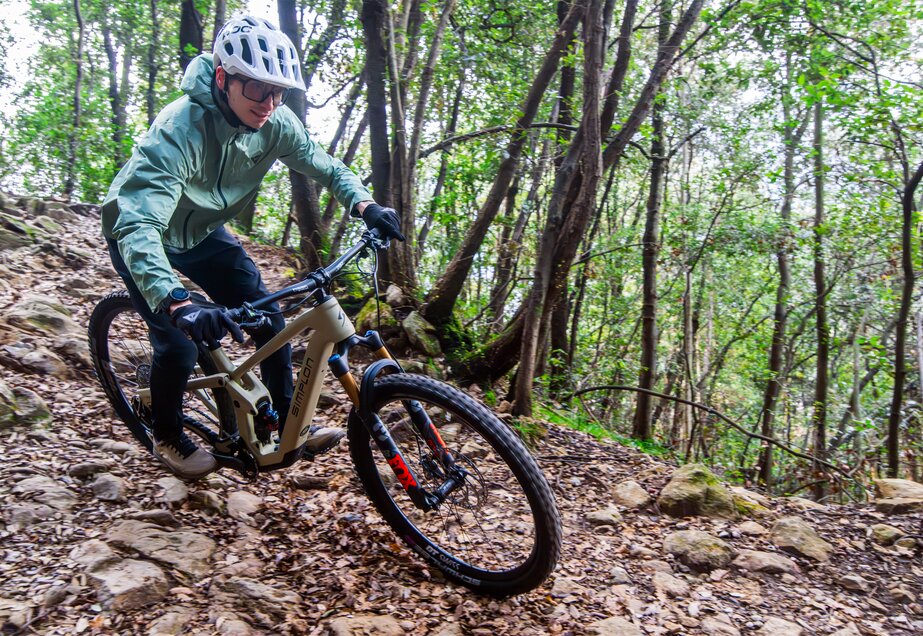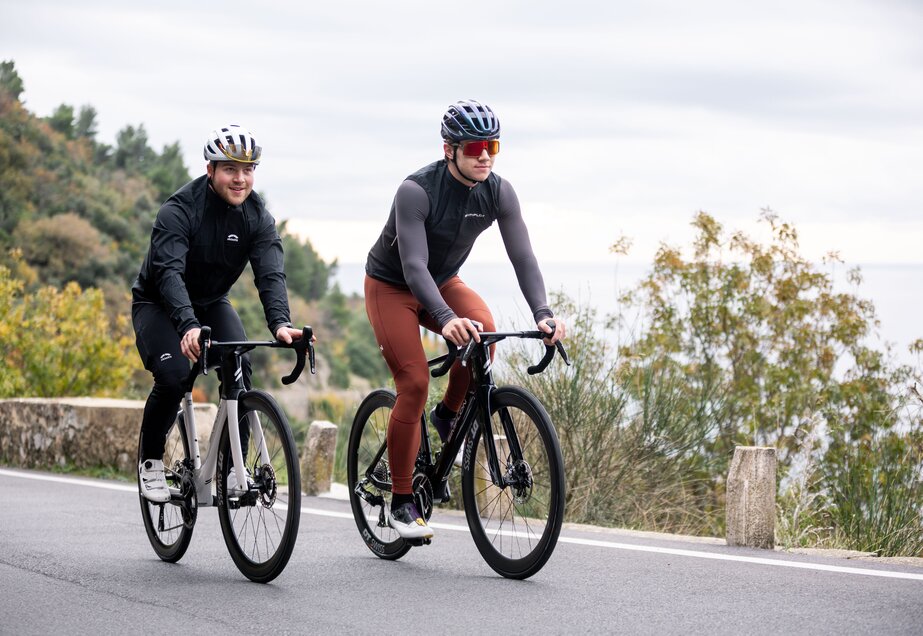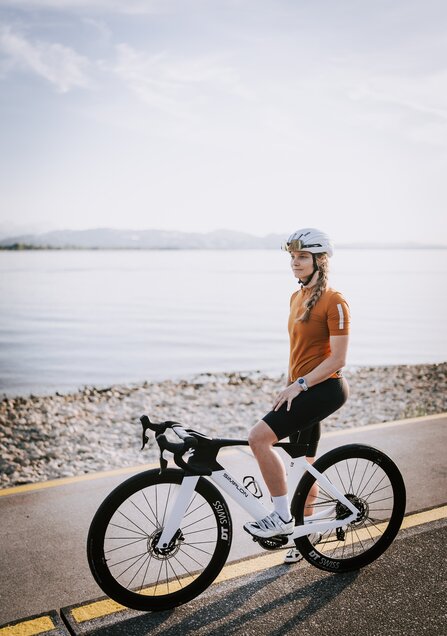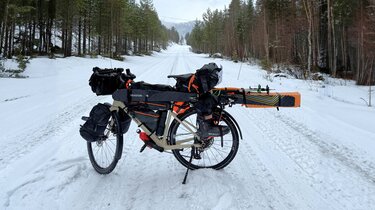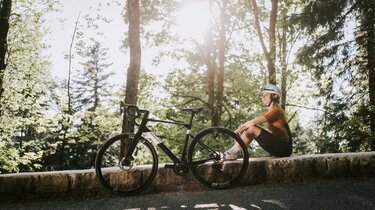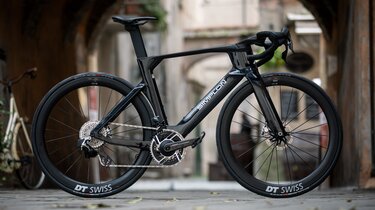

Optimal bike clothing for men & women
Whether you ride a road bike or a mountain bike, find out what matters when it comes to high-performance cycling clothing for women and men – from breathable fabrics to clever layering systems.
Cycling Clothing: Essentials for Every Ride
The right clothing makes all the difference – whether you’re cruising along sunny roads in summer or pushing through wind and rain in winter. With functional cycling apparel, you’ll stay warm, dry and comfortable, so every ride feels smoother and more powerful.
Proven materials play a key role: polyester blends wick away sweat in no time, while merino wool keeps you warm without overheating. That way, you can focus entirely on the ride – not on your outfit.
What cycling clothing makes sense for mountain biking?
When mountain biking, functional, comfortable and flexible clothing is key. Whether it’s a jersey, shorts or a jacket – each piece has its role, and with the right combination you’ll be well equipped for any weather.
1. MTB jersey – short or long sleeves?
Whether you choose short or long sleeves depends on the temperature and your personal preference.
- Short-sleeved jerseys: perfect for warm days and long climbs.
- Long-sleeved jerseys: provide extra protection in cooler conditions or in the woods; easy to remove if it gets too warm.
- Zip jerseys: allow additional ventilation when riding uphill.
- Rear pockets: handy for snacks, phone or small tools.
Tip: Choose breathable, quick-drying fabrics that wick sweat away. Avoid cotton, as it absorbs moisture and cools you down.
2. MTB shorts – long, short or flexible combinations
There are also different options for MTB shorts and trousers:
- MTB shorts: lightweight, flexible and usually with useful pockets – the go-to choice in summer.
- Long MTB trousers: protect against branches, thorns and scratches on technical trails, especially in the woods.
- Leg warmers: turn shorts into long trousers in seconds; pull them up to the thighs and secure with elastic bands.
- Arm warmers: work in the same way for your arms – ideal for changing conditions.
Tip: Look for a comfortable waistband and full freedom of movement. A padded liner short can also be worn underneath to provide extra comfort on longer rides.
3. Jackets & gilets – protection from wind and weather
While a jersey is often enough on the climb, an extra layer is essential on the descent:
- Wind jackets or softshells: breathable, flexible and easy to pack.
- Gilets/vests: protect your core from wind while still allowing airflow; a dropped tail is useful when riding in a sporty position.
- Hardshell jackets: indispensable in the rain or on multi-day tours with changing conditions.
- Waterproof trousers (hardshell): add reliable weather protection for your legs.
Tip: Always keep a lightweight jacket in your pack – it’s the best way to stay prepared for sudden weather changes.
What cycling clothing do you need for mountain biking in winter?
If you’re out on the trails during the colder months, the layering principle is key – upgraded with warming accessories. This way, you stay flexible, dry and well protected from the cold.
- MTB gloves: provide grip, absorb vibrations and wick away sweat all year round – and keep your hands reliably warm in winter.
- Cap under the helmet: protects head and ears from the cold; fleece-lined versions are particularly comfortable.
- Face mask: especially useful on descents, shielding sensitive areas such as nose and mouth from icy wind.
- Multifunctional neck tube: the true all-rounder – can be worn as a scarf, headband or additional face mask.
Tip: Even in winter, always opt for breathable fabrics to let moisture escape and avoid cooling down.
What shoes and socks do you need for mountain biking?
Choosing the right MTB shoes is essential for efficient pedalling and comfort on the trails. There are two main options:
- Clip-in shoes: create a secure connection to the pedal, ensuring maximum power transfer and better control on demanding terrain.
- Flat pedal shoes: provide more freedom of movement, are well suited for technical sections, and are usually more comfortable for walking thanks to their flexible soles.
The right fit is crucial: shoes should sit snugly without pinching, to prevent blisters.
Socks also make a difference:
- Cycling-specific socks keep your feet comfortable and improve grip inside the shoe.
- Ankle-high socks offer extra protection against scratches from branches or grass – and reduce the risk of tick bites on forest or meadow trails.
Tip: Always opt for breathable fabrics. In summer, go for light and thin socks; in winter, choose warming, insulating models.
What cycling clothing is suitable for road cycling?
On the road bike, the layering system is just as important as on the MTB: several layers that can be adapted to the weather. In addition, weight plays a major role – in racing every gram counts – and a tight, aerodynamic fit is essential. Functional, breathable fabrics are key to wicking away sweat and keeping the body dry.
1. Road cycling jersey – tight and aerodynamic
- Short-sleeved jerseys: standard in summer, lightweight and close-fitting for maximum aerodynamics.
- Long-sleeved jerseys: add warmth in cooler conditions or as an extra layer under a jacket.
- Full-length zips: allow flexible ventilation on steep climbs.
- Rear pockets: essential for snacks, gels or small tools – perfect for long rides.
Tip: Choose a jersey with a snug fit but enough freedom of movement – flapping fabric costs watts.
2. Bib shorts and tights – comfort through padding
- Short bib shorts (with straps): the road cycling standard, ensuring a perfect fit without slipping.
- Long tights: for autumn and winter, often with thermal lining and windproof panels.
- Seat pad: the heart of every cycling short, reducing pressure and increasing comfort on long rides.
Tip: The shorts should fit tightly without cutting in. A high-quality chamois pad is essential for comfort – especially on rides of several hours.
3. Jackets & accessories – protection and visibility
- Wind and rain jackets: ultra-light, packable and perfect for changeable weather.
- Arm and leg warmers: quickly transform summer kit into a warmer set-up.
- Overshoes: protect against cold and wet conditions, especially useful in winter.
- Reflective details: increase visibility in traffic – an absolute must for safety.
Tip: A lightweight gilet or wind vest fits easily into a jersey pocket and is the ideal companion for descents or chilly mornings.
What cycling clothing do you need for road cycling in winter?
The colder it gets, the more important the layering system becomes: several layers that keep you warm and can be combined flexibly depending on the ride. In addition to a thermal jersey, winter bib tights and a jacket, the right accessories make all the difference:
- Road shoes with wind- and waterproof overshoes: keep your feet warm and dry while also improving aerodynamics.
- Multifunctional neck tubes: versatile to use – as a scarf, headband or face mask to protect mouth and nose.
- Cap or headband under the helmet: reliably protects your head and ears from the cold without affecting the helmet fit.
- Breathable, windproof gloves: shield against icy wind while still ensuring a secure grip on the bars.
- Reflective details: on jackets, tights or accessories – essential for visibility during the darker months.
Tip: Always go for technical fabrics that wick sweat away from the skin. This way you stay dry on climbs and avoid cooling down on fast descents.
What road cycling shoes and socks do you need?
Choosing the right road cycling shoes is key to efficient power transfer and lasting comfort on long rides.
- Clip-in pedals & road cycling shoes: together they create a secure connection between foot and pedal – ensuring maximum energy transfer with every stroke.
- Typical features: stiff soles, large cleat plates and smooth outsoles – not ideal for walking, but perfect for stability and efficiency on the bike.
- Fit: shoes should be snug without pinching. Good ventilation prevents overheating in summer.
Socks also play an important role:
- Breathable cycling socks: keep your feet dry and create a comfortable climate inside the shoe.
- Thin, seamless models: reduce friction, prevent blisters and avoid unnecessary power loss.
- Ankle-high options: offer extra protection from scratches and dirt.
Tip: The stiffness of road cycling shoes cannot be changed – so comfort depends heavily on the right socks. Opt for technical fabrics that wick away moisture and keep your feet dry even on long rides.
The right clothing is sorted – now all you need is the perfect bike for your next adventure.
- Our road bikes take you fast and efficiently over long stretches of tarmac.
- With our MTBs and e-MTBs, you’re perfectly equipped for trails, descents and off-road adventures.
- And if you can’t decide between road and off-road, our gravel bikes offer the ideal blend of both.
That way, you’re fully equipped – from your outfit to your bike.

